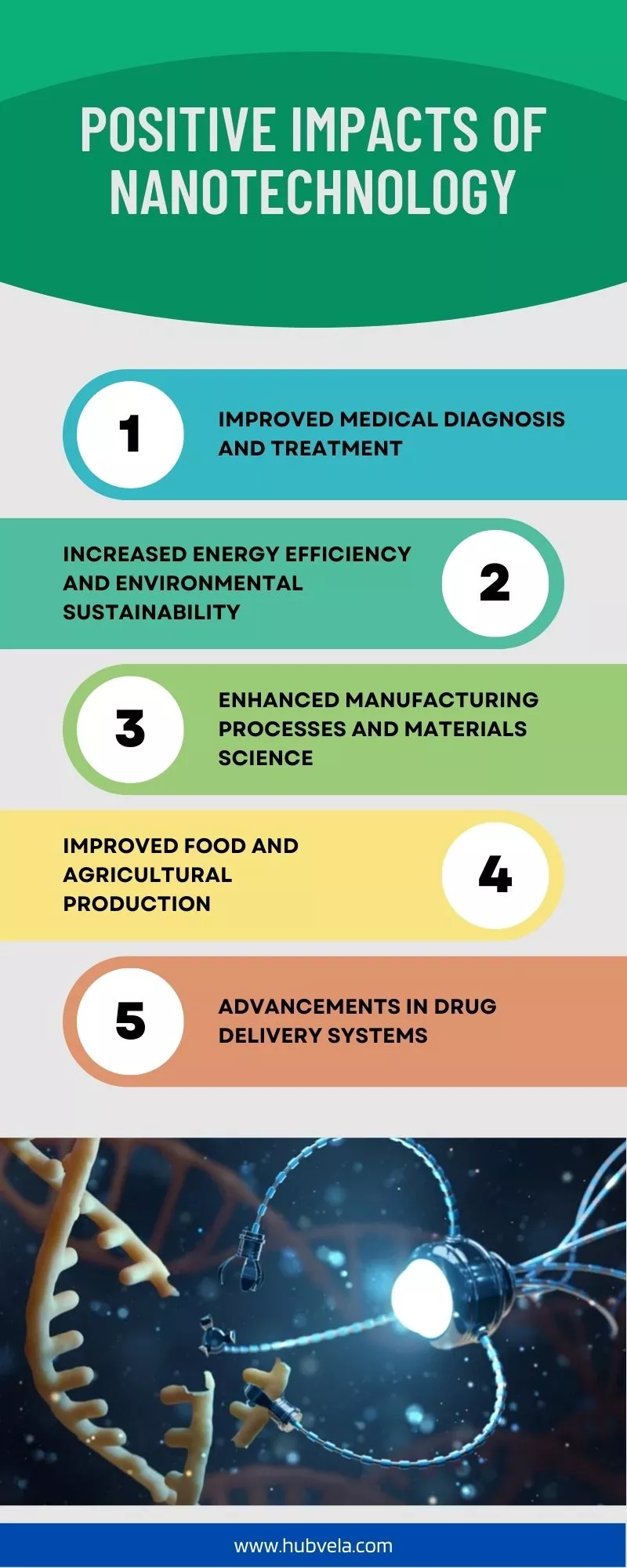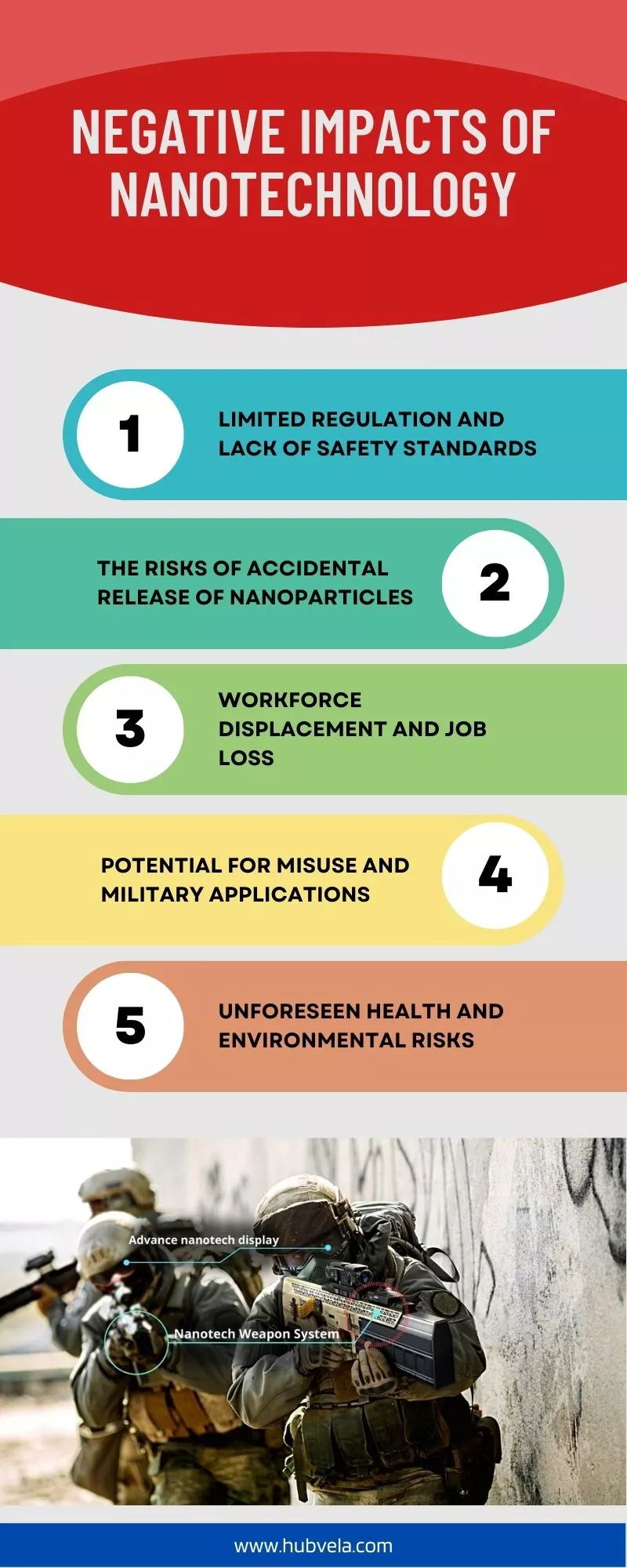Nanotechnology is a rapidly growing field that has the potential to revolutionize many aspects of our lives. It involves the manipulation of matter on an incredibly small scale, with applications ranging from medicine to electronics.
While there are many potential benefits to nanotechnology, such as improved drug delivery and more efficient energy production, there are also concerns about its negative impacts.
In this article, we will explore both the positive and negative impacts of nanotechnology.

--Advertisement--
Positive Impacts of Nanotechnology
The field of nanotechnology is experiencing rapid growth and has the potential to revolutionize many areas of our lives.
From improving the design of everyday products to advancing medical treatments, nanotechnology has numerous applications that can have a positive impact on society.
It has already been used to develop alternative energy sources, improve air quality, and enhance electronics and medical technology.
As research in this field continues, we can expect to see even more innovative uses of nanotechnology that will benefit humanity in countless ways.

1. Improved Medical Diagnosis and Treatment
Nanotechnology has improved diagnostics and patient outcomes by providing clinical alerts and reminders, making it easier to consider all aspects of a patient’s condition, supporting diagnostic and therapeutic decision-making, and gathering all relevant information in one place.
Nanotechnology has also helped improve diagnosis education, which is key to reducing diagnostic errors.
Additionally, nanotechnology has contributed to the development of new treatments for chronic illnesses such as depression.
Overall, the benefits of medical technology have led to improved education for patients about their conditions, treatment options, and likely outcomes.
2. Increased Energy Efficiency and Environmental Sustainability
Nanotechnology has the potential to positively impact energy efficiency and environmental sustainability.
By using nanomaterials, it is possible to create more efficient solar panels, batteries, and other energy storage devices.
Additionally, nanotechnology can be used to improve the insulation of buildings, reducing their energy consumption and carbon footprint.
Energy efficiency is a key component of sustainable development, as it can help reduce greenhouse gas emissions and mitigate climate change.
Incorporating nanotechnology into corporate sustainability strategies can also lead to economic benefits while reducing environmental impact.
Overall, nanotechnology has the potential to contribute significantly to increased energy efficiency and environmental sustainability.
3. Enhanced Manufacturing Processes and Materials Science
Nanotechnology can optimize manufacturing processes to produce a desired chemical without byproducts, which consume energy and material while creating waste.
It is also used to manufacture lightweight stronger materials for boats, sporting equipment, auto parts, and personal care items such as eyeglasses.
Nanomaterials can be designed to improve strength, flexibility, durability, lubricity, and electrical conductivity compared to standard materials.
The ultimate impact of nanotechnology tools will cover a huge range of disciplines including materials science and offer new solutions to key problems such as energy and the environment
4. Improved Food and Agricultural Production
Nanotechnology has the potential to improve food and agricultural production in several ways.
For example, it can be used to develop nanosensors that detect pathogens and contaminants in food, improving food safety.
Nanoparticles can also be used as fertilizers, delivering nutrients more efficiently to crops and reducing the amount of fertilizer needed.
Additionally, nanotechnology can help reduce waste by extending the shelf life of food products through the use of antimicrobial coatings.
5. Advancements in Drug Delivery Systems
Nanotechnology has made significant positive impacts on drug delivery systems.
Recent advancements in drug delivery systems have focused on developing novel drug carriers that can deliver drugs to specific target sites at a pace and extent geared to the demands of the body.
Nanomaterials for drug delivery provide an opportunity to avoid the side effects of systemic drug administration and injury caused by the removal of tumors, delivering great promise for future cancer treatments.
Conventional dosage forms like tablets and capsules are associated with low bioavailability, frequent application, side effects, and patient noncompliance.
Therefore, nanotechnology-based drug delivery systems have emerged as a promising alternative to conventional dosage forms.
Negative Impacts of Nanotechnology
Nanotechnology is a rapidly growing field with many potential benefits, including advancements in medicine and environmental protection.
However, like all technologies, it also has the potential for unintended negative impacts on both human health and the environment.
Some of these risks include the creation of new toxins and pollutants, as well as unknown health effects from exposure to nanoparticles.
We explore some of the main negative impacts of nanotechnology.

1. Limited Regulation and Lack of Safety Standards
Nanotechnology has the potential to revolutionize many industries, but it also poses risks due to limited regulation and lack of safety standards.
The absence of clear regulations and safety standards can lead to inadequate protection for workers and consumers from exposure to potentially harmful nanoparticles.
This can result in negative impacts on human health and the environment. It is important for regulatory bodies to establish guidelines for the safe handling, use, and disposal of nanomaterials.
Employers should also implement safety management programs that prioritize worker safety and health.
Engineers have a responsibility to consider ethical implications when developing new technologies, including nanotechnology, to ensure that they do not cause harm to society or the environment.
2. The Risks of Accidental Release of Nanoparticles
Nanotechnology has the potential to bring many benefits, but it also poses risks.
One of these risks is the accidental release of nanoparticles into the environment, which can have negative impacts on human health and the environment.
Accidental releases can occur during the manufacturing, transportation, use, and disposal of nanomaterials.
The likelihood and consequences of such releases are difficult to predict due to the complex nature of nanomaterials and their interactions with biological systems.
Therefore, it is important to conduct thorough risk assessments and implement appropriate safety measures to minimize the risk of accidental releases.
Regulatory bodies such as FDA and OSHA are working towards developing guidelines for the safe handling and disposal of nanomaterials.
3. Workforce Displacement and Job Loss
Nanotechnology has the potential to create negative impacts on the workforce, leading to displacement and job loss.
The consequences of job displacement can be severe, including psychological trauma and financial instability.
Automation is one area where nanotechnology could lead to job loss, with studies showing that industries adopting automation have seen an average of 17-16% displacement from 1947-2016.
Additionally, the clean energy transition has already led to significant job losses in coal mining and power generation.
It is important for policymakers and businesses to consider the potential negative impacts of nanotechnology on the workforce and take steps to mitigate them.
This could include investing in retraining programs or creating new job opportunities in emerging fields.
4. Potential for Misuse and Military Applications
Nanotechnology has the potential for misuse and military applications. The military is interested in nanotechnology for various purposes, including increased surveillance, exploration of oceans, augmenting human performance, and developing stronger and cheaper materials.
However, the use of nanotechnology in military applications raises ethical concerns about its potential misuse.
Additionally, while nanotechnology has direct beneficial applications for medicine and the environment, it may have unintended effects that can adversely impact the environment and human health.
Therefore, it is important to consider the negative impacts of nanotechnology on society before implementing it in various fields.
5. Unforeseen Health and Environmental Risks
The long-term environmental impacts of nanotechnology remain uncertain. Air pollution caused by various sources, including wildfires, has been linked to a wide range of health issues such as reduced lung function, exacerbation of asthma and heart failure, and premature death.
On the other hand, the coronavirus crisis has led to slashed greenhouse emissions. Poor air quality is also linked to low birth weight and SIDS.
Noncommunicable diseases like chronic respiratory diseases and cancers are frequent disease outcomes caused by environmental factors.
Therefore, it is important to consider the potential negative impacts of nanotechnology on both human health and the environment.
Conclusion on the Positive and Negative Impacts of Nanotechnology
In conclusion, nanotechnology has both positive and negative impacts on the environment and society. On the positive side, it has led to advancements in various fields such as medicine, energy, and electronics.
Nanosensors have made disease detection easier and cost-effective, while solar power has become more economical due to the reduced costs of constructing solar panels.
However, the unrestricted development of nanotechnology has led to the enormous use of nanoparticles that can have negative environmental impacts.
The potential risks associated with nanoparticles need to be carefully studied and addressed through appropriate policies and regulations.
Overall, nanotechnology is a promising field that requires responsible development and management to ensure its benefits outweigh its potential risks.


